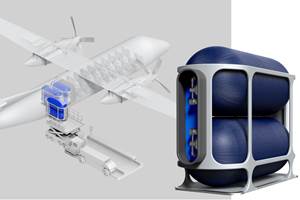Collaborators awarded NIST funding to develop in-space manufacturing roadmap
Purdue, the University of New Hampshire and the University of Alabama will work with NASA to develop a roadmap for in-space manufacturing.

A new program to enable commercialization, industrialization and democratization of in-space manufacturing (ISM) is being undertaken by collaborators from from NASA, Purdue University’s College of Engineering (West Lafayette, Ind., U.S.), the University of New Hampshire (UNH, Durham) and the University of Alabama (Tuscaloosa).
Through the National Institute of Standards and Technology (NIST, Gaithersberg, Md., U.S.) Advanced Manufacturing Technology Roadmap Program (MfgTech), more than $3.25 million has been awarded in 2022 to universities and nonprofit organizations to develop manufacturing technology roadmaps to strengthen U.S. innovation and productivity across entire industry sectors.
In May 2022, UNH and collaborators were awarded $297,877 by NIST to explore a new paradigm in manufacturing for the equitable commercialization, industrialization and democratization of ISM. To create the roadmap, researchers will analyze barriers to commercializing a space-based manufacturing economy, recommend solutions and develop guides that will help strengthen U.S. leadership in space, economic growth and national defense.
Purdue team members include: Ajay Malshe, the R. Eugene and Susie E. Goodson Distinguished Professor of Mechanical Engineering; Michael Sealy, associate professor of mechanical engineering; Salil Bapat, staff research scientist; Steve Shade, Ball Brothers Director of Advanced Manufacturing Initiatives; and Luz Sotelo, who will start as an assistant professor of mechanical engineering in spring 2023.
“If we are going to build the economy between here and the moon — if we’re going to put that flag in the ground — the first thing we need to build is infrastructure. Manufacturing is the very heart of that infrastructure,” Malshe says.
The team, along with industrial, government and academic partners, will analyze technical and commercial gaps for a space-based manufacturing economy, such as in low-earth orbit (LEO) and on the lunar surface.
There is a growing demand for launching satellites, supplies and spare parts into space via rockets, which carries an expensive price tag, not to mention demanding efficiency. The long-term vision for the success of ISM must explore complex issues such as logistics and supply chain in extreme environments, operating manufacturing processes like 3D printing in zero gravity, maintenance, qualifying parts manufactured in space, gathering raw materials, building space-friendly robots, autonomous vehicles and many more.
“While manufacturing processes and supply chain systems have been optimized for the fabrication of products on Earth, extensive fundamental and applied R&D related to ISM must be conducted. Our roadmapping effort will identify and prioritize the technical barriers in order to accelerate the commercialization and democratization of space,” says Brad Kinsey, professor of materials science and mechanical engineering at the John Olson Advanced Manufacturing Center.
This will be the world’s first private sector-driven roadmapping effort in ISM specifically for commercial applications. Any roadmapping effort typically attracts small and large industries, which is very important, Malshe says.
“NASA is very interested in this roadmap effort to explore transformative approaches for in-space manufacturing that aim to provide benefits both on Earth and in space,” says John Vickers, principal technologist for advanced manufacturing at NASA, is one of the project collaborators. “Advanced research and technology demonstrations will be essential for deep space exploration and development of commercial capabilities for future U.S. leadership in space.”
Additional team members include James Reilly, retired NASA astronaut who now leads the Advanced & In-Space Manufacturing Initiative partnership between the University of Alabama and NASA’s Marshall Space Flight Center, and John Roth, professor of mechanical engineering and director of the John Olson Advanced Manufacturing Center at UNH.
Related Content
Carbon fiber in pressure vessels for hydrogen
The emerging H2 economy drives tank development for aircraft, ships and gas transport.
Read MoreThermoplastic composites welding advances for more sustainable airframes
Multiple demonstrators help various welding technologies approach TRL 6 in the quest for lighter weight, lower cost.
Read MoreMaterials & Processes: Resin matrices for composites
The matrix binds the fiber reinforcement, gives the composite component its shape and determines its surface quality. A composite matrix may be a polymer, ceramic, metal or carbon. Here’s a guide to selection.
Read MoreThe state of recycled carbon fiber
As the need for carbon fiber rises, can recycling fill the gap?
Read MoreRead Next
Composites end markets: Energy (2024)
Composites are used widely in oil/gas, wind and other renewable energy applications. Despite market challenges, growth potential and innovation for composites continue.
Read MoreCW’s 2024 Top Shops survey offers new approach to benchmarking
Respondents that complete the survey by April 30, 2024, have the chance to be recognized as an honoree.
Read MoreFrom the CW Archives: The tale of the thermoplastic cryotank
In 2006, guest columnist Bob Hartunian related the story of his efforts two decades prior, while at McDonnell Douglas, to develop a thermoplastic composite crytank for hydrogen storage. He learned a lot of lessons.
Read More
.jpg;width=70;height=70;mode=crop)

























